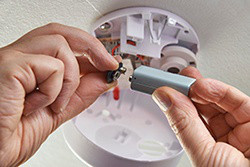 As Daylight Savings Time comes to end and you rewind your clocks, take a moment to change out the batteries of your smoke detectors.
As Daylight Savings Time comes to end and you rewind your clocks, take a moment to change out the batteries of your smoke detectors.
The risk of home fires is real. And their impact can be quite dangerous, as well as costly. Consider the following statistics from the National Fire Protection Association (NFPA) and Ready.gov:
- In 2014, one home structure fire was reported every 86 seconds.
- 84% of all fire deaths occur in home fires.
- Annually, more than 2,500 people are killed and another 12,600 injured in home fires.
- Fires cause approximately $7.3 billion in direct property loss due to home fires each year.
- When fires occurred and smoke alarms were present but did not operate, 46% of the smoke detectors had missing or disconnected batteries and 24% had dead batteries.
- By having a working smoke detector you decrease the chance of fatal fires by a factor of two.
Make sure smoke alarms and fire safety are part of your personal risk management strategy. Do you have smoke detectors in place? Are they properly functioning? Does your family have a fire escape plan and have you practiced it? Ready.gov provides helpful resources to prepare your family on how to prevent home fires, as well as what to do before, during, and after a fire occurs.
Specific to smoke alarms, the NFPA offers these important tips:
- Install smoke alarms inside and outside each bedroom and sleeping area. Install alarms on every level of the home. Install alarms in the basement.
- Large homes may need extra smoke alarms.
- It is best to use interconnected smoke alarms. When one smoke alarm sounds they all sound.
- Test all smoke alarms at least once a month. Press the test button to be sure the alarm is working.
- There are two kinds of alarms. Ionization smoke alarms are quicker to warn about flaming fires. Photoelectric alarms are quicker to warn about smoldering fires. It is best to use both types of alarms in the home.
- A smoke alarm should be on the ceiling or high on a wall. Keep smoke alarms away from the kitchen to reduce false alarms. They should be at least 10 feet (3 meters) from the stove.
- People who are hard-of-hearing or deaf can use special alarms. These alarms have strobe lights and bed shakers.
- Replace all smoke alarms when they are 10 years old.
Testing your smoke alarm and changing the batteries is an easy preventive measure that can help save you and your loved ones in an emergency.



